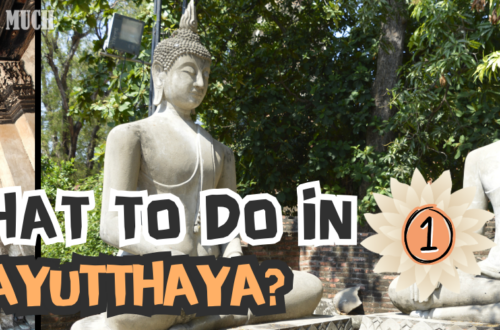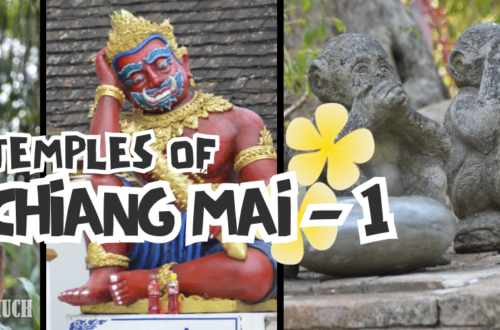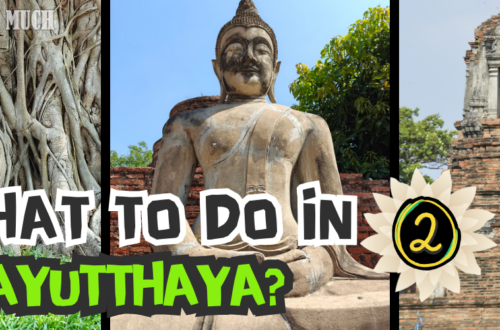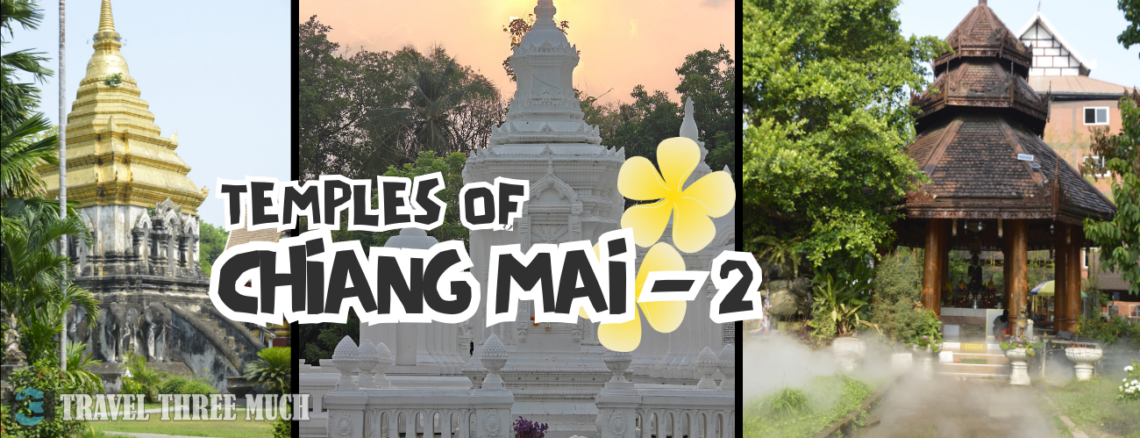
Temples of Chiang Mai: Beyond Tourist Trails – Part 2
Here is the second part of our 2 part blog on the temples of Chiang Mai.
Wat Sri Suphan
Wat Sri Suphan is the ‘Silver Temple’ Of Chiang Mai. Over two centuries ago, silversmiths from Burma’s Kengtung area settled in the nearby Wua Lai area. Today, this neighbourhood continues to showcase the remarkable talents of silversmiths and lacquerware artists.
In 1500 CE, King Mueangkaew commissioned the original wihan. The ordination hall (Ubosot) and chedi were added nine years later. The wihan and chedi underwent two major reconstructions: first between 1860-1863 CE under Kawilorot Suriyawong’s reign, and again in 1993 CE, both to repair the ravages of time. The silver Ubosot hall, which gives the shrine its nickname, was built by local silversmiths from 2004 to 2016 CE as a unique community-driven project. The hall’s outer and inner panels are made of different materials – aluminium, silver, and nickel.
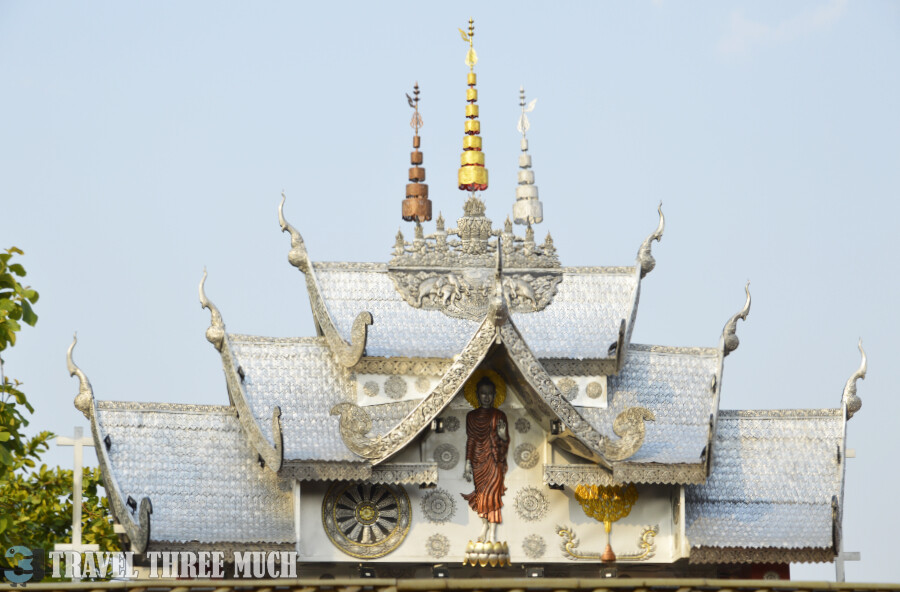
![]() Plan your trip
Plan your trip
- Construction date: 16th century CE; Chedi and Wihan renovated in: 19th century CE, reconstructed in 20th century CE
- Timings: 6:00 AM to 5:30 PM on all days except Saturday when the closing time is 9:30 PM
- Entry fee: 50 THB per person
- Getting there: Walk/Tuk-tuk/Songthaew/Taxi
- Note:
- Women are forbidden entry only to the Ubosot (ordination) hall, even if the entry fee is paid.
- Buddhist temple attire rules apply.
- Only street parking is available. If you’re driving a rented car, keep in mind that due to the narrow access roads and streets, parking near the temple could be tricky.
The Architecture
A few teak pillars and framing structures are probably the only remnants of the original temple from five centuries ago. A magnificent garuda mounted on a wooden wall showcased the artisans’ skills. A silver and gold Ganesha idol, with an ‘Om’ symbol on his forehead and shaded by a silver parasol adorned with zodiac symbols, symbolized the blend of Hindu and Buddhist theologies. In front of the deity, four mice statues of various sizes held offerings.

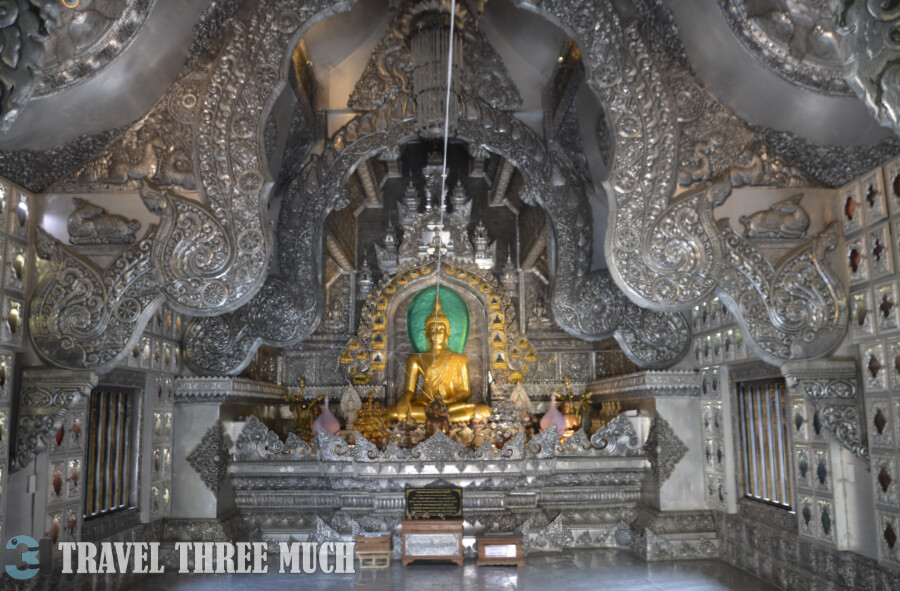
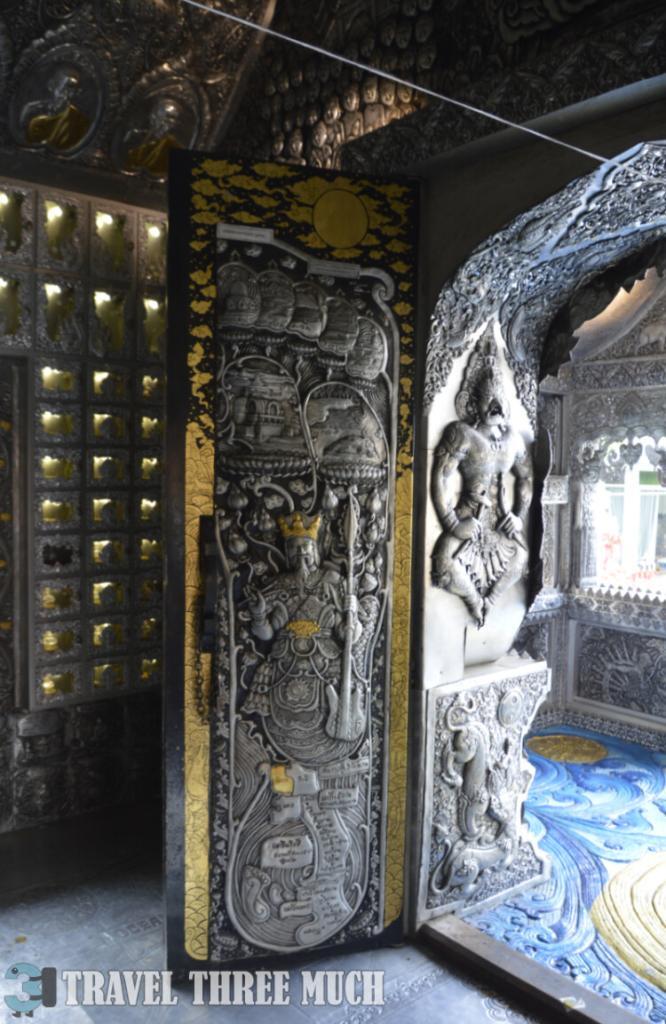
Inside the wihan, we were greeted by life-like Buddha statues in four different sizes, all shimmering in gold and silver. A prayer ceremony was in progress, with threads connecting the Buddha images to the roof beams, adorned with hanging Thai currency notes, possibly for good fortune and prosperity. A monk blessed us and handed us a paper with his blessing in English and Thai. The walls of the wihan came alive with a series of pictures depicting a Jataka tale.
Next, we visited the Ubosot hall, where two Buddha images—one golden and one silver—stood on either side. The entrance featured Naga bannisters, with many-headed snakes shading the kneeling Thewas. Inside, the hall’s silver panels were intricately crafted using both chasing (hammering designs from the outside) and repoussé (beating designs from the inside) techniques.
The themes on these panels ranged from Theravada Buddhism and Taoism to whimsical science fiction doodles, the Venus of Willendorf, the evolution of apes into humans, and bizarre scenes of monstrous skulls with people standing atop them. The effect was quite psychedelic, with only the Buddha image reminding us we were in a place of worship and not a modern art museum.
Near the Ubosot, twin yaksha demons stood guard over a sacred Bo (peepal) tree. On our way out, we passed statues of King Mueangkaew and Queen Rachamanda Jao Siriyasuwadee, the royal patrons of the original Wat Sri Suphan, positioned near the Ganesha idol.
Wat Sri Suphan is a unique temple, showcasing exquisite craftsmanship that continues to thrive. Our driver also enjoyed the visit, eagerly pointing out several unique sights we might have otherwise missed.
Wat Suan Dok
Wat Suan Dok, meaning “Temple of the Flower Garden” in Thai, was once the Royal Flower Garden of Chiang Mai’s ruler. A monk from Sukhothai named Sumana Thera discovered a relic believed to be the Buddha’s shoulder bone. Invited by King Kuena, the monk brought the relic to Chiang Mai, where it miraculously split into two pieces. The larger piece was placed on the back of a white elephant, which led the king to the Doi Suthep mountain. The creation of Wat Pha Lat and Wat Doi Suthep temples was the result of the royal entourage’s expedition up the mountain, hot on the heels of the elephant.
In the second half of the 14th century, King Kuena built Wat Suan Dok to enshrine the smaller piece of the relic within a giant golden chedi crafted in the Lankan style. The temple’s Ubosot hall houses a Buddha statue cast from the early 16th century. In 1907 CE, Princess Dara Rasmi directed the transfer of Lan Na royalty ashes from various parts of Chiang Mai to Wat Suan Dok, to be enshrined in white chedi mausoleums. The wihan and Ubosot halls were reconstructed in 1930 CE by the renowned monk Khru Ba Srivichai.
![]() Plan your trip
Plan your trip
- Construction date: 14th century CE, renovated in the 20th century CE
- Timings: 6:00 AM to 6:00 PM on all days
- Entry fee: 20 THB per person for tourists; Entry free for Thai citizens and children
- Getting there: Walk/Tuk-tuk/Songthaew/Taxi
- Note:
- Do not miss the mausoleums with the white chedis adjoining the wihan! These are the final resting places of Lan Na royalty’s remains.
- Wat Suan Dok also has the Chiang Mai campus of the Maha Chulalongkorn Rajavidyalaya Buddhist University, which also organises monk chats and meditation retreats here.
- This is a functional temple and so, all Buddhist temple attire rules apply.
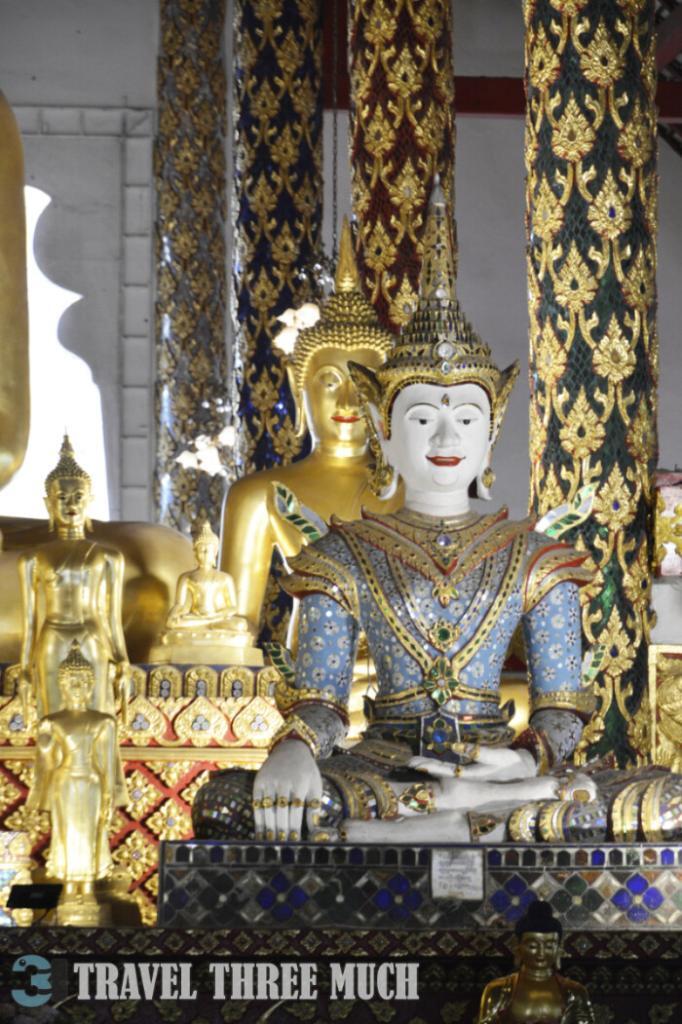
We arrived at Wat Suan Dok in the evening. While the ubosot hall was closed, the wihan was open, revealing an impressive facade adorned with gilded carvings and a sculpted tiger in relief. Inside, two rows of seated Buddha images, dressed as both prince and mendicant, sat in meditative (Dhyanamudra) and earth-witness (Maravijaya) poses. A giant seated Buddha towered over them, and on the other side of the altar, we saw images of the monk Khru Ba Srivachai and a tall standing Buddha holding a bunch of straws in his right hand.
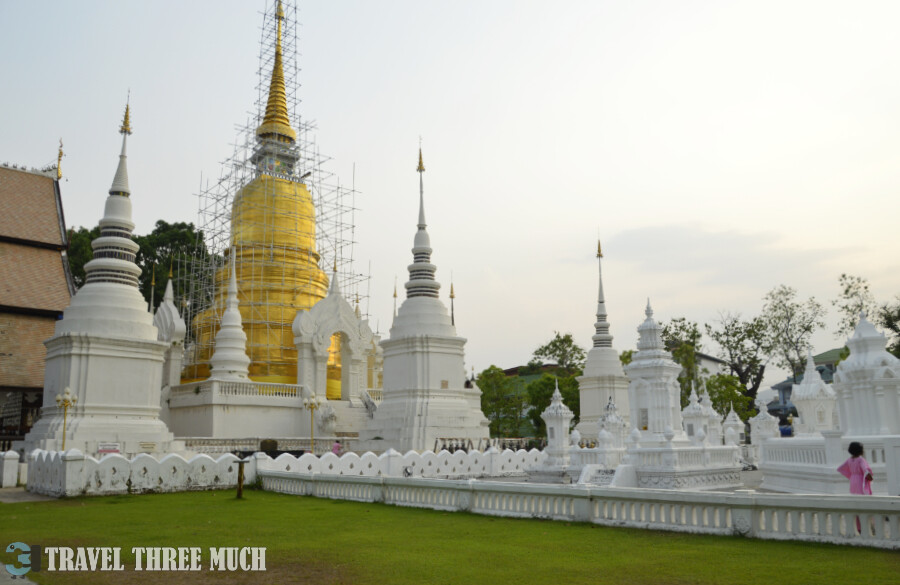
We strolled around the temple grounds, admiring the giant golden chedi in the Lankan style, which was under renovation with scaffolding around the dome. Crepuscular rays framed the white mausoleum chedis against the Doi Suthep mountains, creating a stunning scene. Some kids playing football enthusiastically in the grounds adjoining the mausoleum reminded us of the joie de vivre within our transitory lives.
We bid a fond farewell to the pristine white mausoleums, the dying light from the setting sun setting the sprawling wihan’s roof aflame in evening hues, and the majestic golden chedi set against the backdrop of the Doi Suthep mountain – the perfect setting to meditate on the mysteries of life.
Wat Lok Moli
The origins of Wat Lok Moli or as it is sometimes written, Wat Lok Molee, are somewhat unclear, with the first recorded mention in 1367 CE when King Kuena of Lan Na invited ten Burmese Theravada Buddhist monks to reside there. The chedi was built in 1527-28 CE by King Chettharat to house the ashes of the Mengrai dynasty. The wihan was commissioned by King Ket in 1545 CE.
Wat Lok Moli stands out for several unique features. Unlike most Buddhist temples, it aligns along a north-south axis instead of the typical east-west orientation. The Lan Na style chedi, with its exposed brickwork and absence of stucco, plaster, or gilding, suggests Angkorian influence. Inside the teak wihan, intricate carvings of the Vessantara Jataka adorn the walls. These stories of the Buddha’s past lives are central to the Thet Mahachat festival, where monks recite the tales, and attendees gain extra merit by listening.
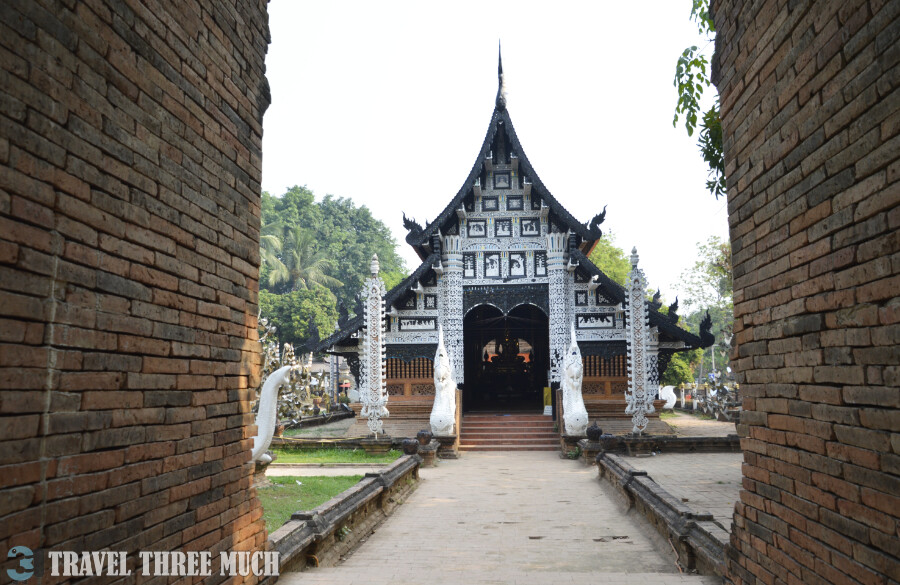
![]() Plan your trip
Plan your trip
- Construction date: Temple from the 14th century CE; Chedi and wihan from the 16th century CE; Renovated in the second half of 20th century CE
- Timings: 6:00 AM to 7:00 PM
- Entry fee: No entry fee
- Getting there: Walk/Tuk-tuk/Songthaew/Taxi
- Note:
- Buddhist temple attire rules apply here as it’s a functional temple.
- Don’t miss the wihan made almost entirely of teak wood, and lacquered in black with Vessantara Jataka carvings, and the massive Lan Na style chedi with a Burmese finial.
- The temple doesn’t seem to have an ubosot hall but has a few wooden shrines dedicated to King Ket and Queen Chiraprapha of Chiang Mai.
We visited Wat Lok Moli early in the morning to avoid the crowds.
The Architecture
At the entrance, two fierce yakshas—one green and the other red—stood guard. Just beyond them, two life-size elephant statues greeted us with outstretched trunks. The first structure that caught our eye was the magnificent wihan. Giant Nagas with beaks served as balustrades for the entry stairs. Stuccoed totem poles, each with ten insets featuring Thai zodiac animals, stood nearby, seemingly defying gravity with minimal support. Off to one side, a bo tree adorned with silver and golden leaves and hanging bells added to the serene atmosphere.
Inside the wihan, a central Buddha figure sat in a meditative posture, flanked by smaller standing Buddhas. Early morning sunlight streamed through the delicate trelliswork and turned pillars in the wooden windows, creating intricate patterns on the wihan’s floor.


Next, we visited the towering chedi with its exposed brickwork. Simple yet immense, the chedi featured a golden Burmese-style finial on top. Niches housed Buddha images, wall pilasters displayed supplicant devatas, and celadon chinthe lions adorned the base. A black stone Buddha image in a niche had a string running from the base of the chedi, with a gilt hamsa (swan) attached for making a water offering. The durability of the materials amazed us. Stucco figures of the twelve Thai zodiac animals lined the pathway around the chedi. From here, we saw a statue of King Naresuan surrounded by rooster statue offerings, commemorating the legend of his victory in a rooster fight that regained Ayutthaya’s independence.
A gilt statue of Brahma, the four-headed creator in the Hindu pantheon, sat under a parasol near the entrance. A wooden pavilion housed beautiful statues of Queen Chiraprapha and her spouse, King Ket. Nearby, a building used by monks to meet worshippers and receive offerings had two Dtuwamaum monsters, or ‘mom,’ guarding its entrance. The archway featured ornate stucco work and was topped by a throne with a statue of King Kuena, flanked by two guardsmen statues. A shrine with a statue of Guanyin, the many-armed goddess of mercy, stood next to this hall.
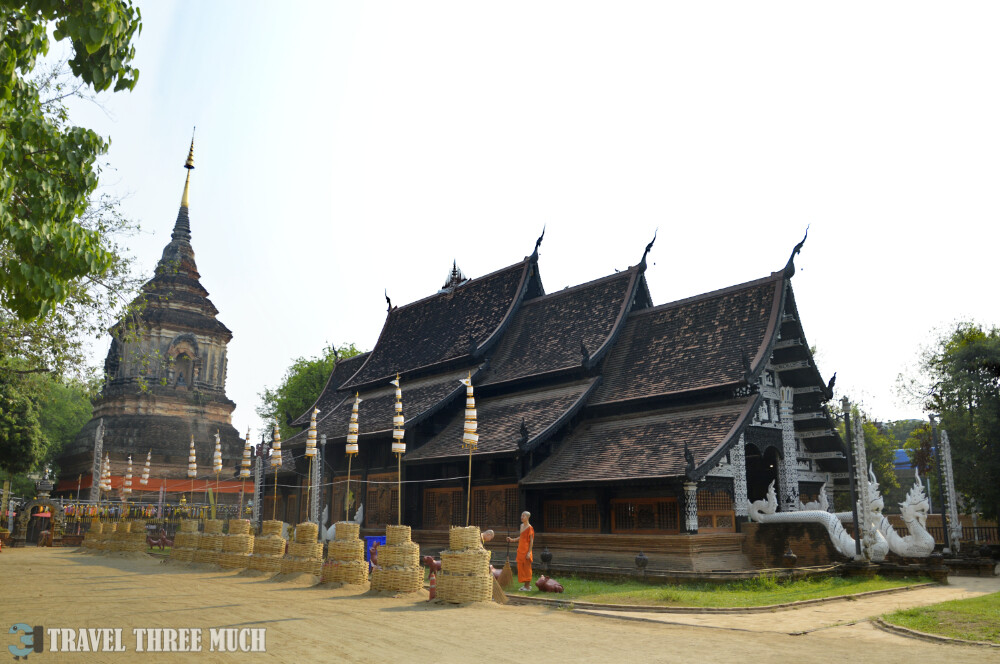
Wat Lok Moli is a beautiful and unique temple worth exploring, with many hidden nooks waiting to be discovered.
Wat Chiang Man
Before the Mengrai dynasty established Lan Na, the Lawa people lived in present-day Chiang Mai. When King Mangrai decided to move his capital from Chiang Rai, he used Wiang Nopburi, a fortified town, as a construction camp while building the new capital. At this site, King Mangrai, with King Ramakamhaeng of Sukhothai and King Mueang of Phayao, ordered the construction of a chedi in the late 13th century. This site became Wat Chiang Man, the royal temple of Chiang Mai at that time. The temple features Buddha sculptures from the Haripunchai kingdom as well as from India and Sri Lanka.
![]() Plan your trip
Plan your trip
- Construction date: Chedi – 13th century CE and restored in 15th century CE; Buddha image in the large wihan – 15th century CE; Crystal Buddha in the smaller wihan – 2nd century CE; Marble Buddha in the smaller wihan – 8th to 10th century CE; Ubosot hall – 19th century CE; New Ho Trai – 20th century CE
- Timings: 6:00 AM to 5:00 PM
- Entry fee: No entry fee
- Getting there: Walk/Tuk-tuk/Songthaew/Taxi
- Note:
- Buddhist temple attire rules apply here as it’s a functional temple.
- The temple and the Buddha statue in the main (larger) wihan are the oldest in Chiang Mai.
- Don’t miss the ancient Buddha images housed in the smaller wihan.
- The ubosot is usually closed to visitors.
When we visited the temple, it was very quiet, seemingly off the tourist circuit. Other than a few locals, we saw hardly any visitors. A black-collared starling with a large beak patrolled the grounds in front of the closed ubosot, or ordination hall.

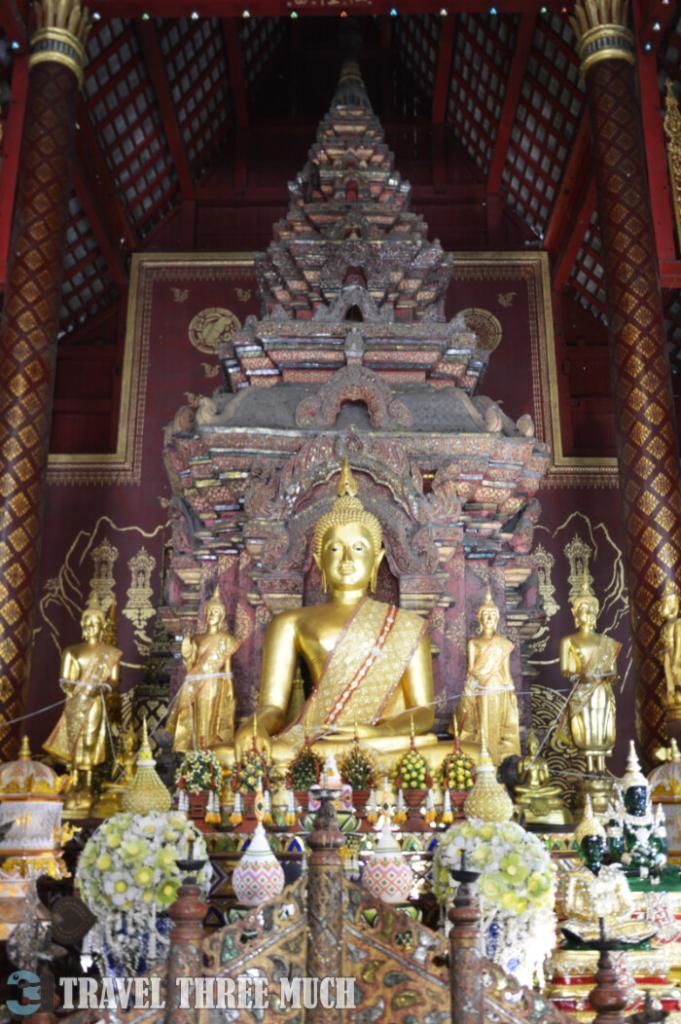
The Architecture
The ubosot’s facade featured ornate gilt carvings on the gable, with golden Lan Na-style Nagas descending from the roof. The doors had golden murals of floral motifs on a vibrant red background, topped by a floral capital with Thai zodiac animals. The doors were flanked by pillars decorated with coloured glass. Although the new ubosot dates from the reign of King Kawila in the 19th century, the original ubosot, from the 13th century, was restored in the 16th century. A stone stele on the right side of the porch had Thai inscriptions about the founding of Chiang Mai.
Next, we explored the chedi, named Chedi Chang Lom, meaning “the chedi with elephants around it.” The chedi sat atop a square base with the front halves of 15 life-sized stucco elephants protruding from the walls. The next level had niches with Buddha images, and atop this was the gilded reliquary chamber and golden finial. This chedi is a fusion of Sinhalese, Indian, and Lan Na styles. We spent quite a while walking around, marvelling at the artisans’ skills.
The new Ho Trai, or manuscript library, stood in a lotus pond on a stilted foundation. Two gigantic Nagas guarded the entrance bridge. The Ho Trai’s location was chosen to protect the palm leaf manuscripts from insects.
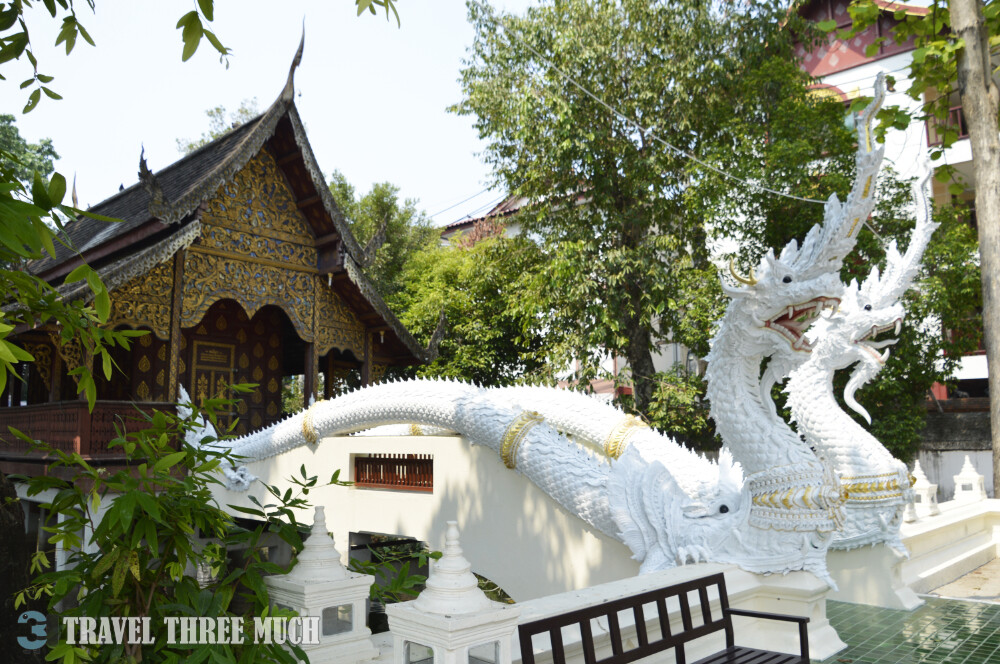
The main, larger wihan had an altar with a central seated Buddha statue flanked by more Buddha images in different poses. One standing Buddha had the date 1465 CE engraved on its base. The altar had spectacular murals, and a stucco temple structure decorated with coloured glass served as a backdrop to the Buddha images. A nearby structure informed us that the monk Khru Ba Srivichai, also responsible for the renovations of Wat Suan Dok, renovated Wat Chiang Man in 1932.
The smaller wihan housed two exquisite and ancient Buddha images: a Buddha carved from quartz crystal, aptly called the Crystal Buddha (Phra Setangamani), and a Buddha carved in bas relief, called the Marble Buddha (Phra Si La). The Crystal Buddha is said to have accompanied King Mangrai to Chiang Mai after his conquest of the Haripunchai kingdom in the 13th century. The Marble Buddha, depicting the taming of the elephant Nalagiri by a standing Buddha, is thought to have originated from either India or Sri Lanka and is dated to the 8th to 10th century.
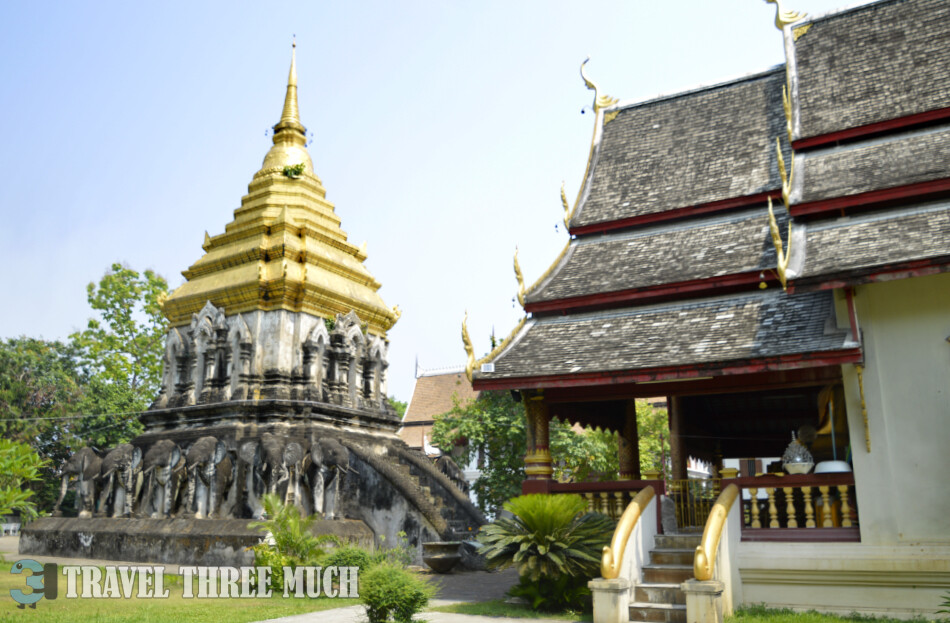
Wat Chiang Man is a fascinating destination for those interested in the roots of Chiang Mai and the Lan Na schools of art and architecture. After our walk around the temple, we headed out for a quick bite. “Into The Woods,” a fairytale-themed restaurant and library rolled into one, was the perfect spot to rest our tired limbs and grab some drinks and snacks while our kid got lost in a book.
This concludes our travelogue of the temples of Chiang Mai. For more interesting trivia and tips on itinerary planning, check out our blog on Ayutthaya here!

